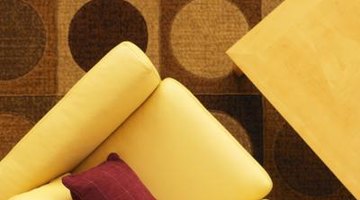How to Arrange Furniture on an Angle
A ring-around-the-room syndrome can happen to even the best decorators. But one of the quickest ways to change this vibe begins with arranging furniture on an angle. With angled furniture placement, you can create a cozy seating area while making your space look larger and feel more inviting. It may seem strange at first to depart from the standard furniture-against-the-walls layout, but an afternoon spent angling your furniture quickly gives your room a fresh new look.
Highlight a Focal Point

In rooms with a corner fireplace or window, you have a ready-made design feature around which to build an angled furniture placement. In rooms large enough, set the sofa in the middle of the room facing the fireplace. Place the loveseat and chairs at a 90-degree angle on either side of the sofa to create an inviting seating area. Complete the layout with a coffee table and end tables strategically placed. This arrangement invites interaction and conversation when compared with the furniture-against-the-walls approach.
Soften a Linear Design
Linear and grid-like designs make a strong statement that appeals to those who like modern decor. But too much of a good thing can become overpowering, as when the flooring, shelving and furniture tufting all repeat the same boxy design. By placing the furniture on an angle, especially in relation to a focal point, you add a new dimension to the room that offsets the rigidity of a strict grid layout.
Break Up a Large Space
When you are furniture-challenged by lofts and large interior spaces, pull the furniture away from the walls to create angled groupings instead. Use angled furniture layouts to separate the different functional areas of the same space. For example, you can organize a loft with a formal seating area placed parallel to the walls and assemble the dining area on an angle. The dining set's angle makes it visually distinct from the rest of the space. It signals a shift in function and mood from the living area.
Float Your Furniture
Add furniture pieces light in appearance to let them float in the room. This helps to create a sense of spaciousness in smaller rooms. But soften the angles when you use this method. Pull one corner of the sofa away from the wall and turn the occasional chair to face slightly in to the sofa. The entire space opens up and seems to breathe when you do this. But don't forget to pay attention to traffic zones and flow when arranging a room layout at an angle.
References
Resources
Writer Bio
Jan Burch has written about home, garden, wellness and other topics since 1992. Her articles have appeared in ByLine, Living Natural and New Mexico Woman. Based in Albuquerque, Burch is a Feng Shui consultant and Jin Shin Jyutsu practitioner. A life-long crafting enthusiast, she holds a master's degree from the University of California.
Photo Credits
- George Doyle/Stockbyte/Getty Images
More Articles
- The Best Arrangement for a Sofa, Loveseat, and Recliner in a Square Room
- How to Turn a Ranch-Style Home Into French Country
- DIY Decor Ideas to Break Up a Sectional Sofa
- How to Decorate a Parlor Room
- How to Decorate a Long Narrow Living Room With a Fireplace on a Side Wall
- How to Make a Futon Feel Like a Couch


